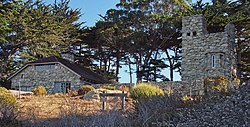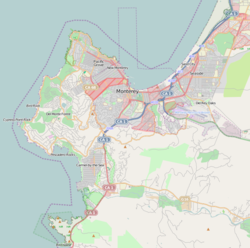| This article needs additional citations for verification. Please help improve this article by adding citations to reliable sources. Unsourced material may be challenged and removed. Find sources: "Tor House and Hawk Tower" – news · newspapers · books · scholar · JSTOR (July 2021) (Learn how and when to remove this message) |
| Robinson Jeffers House | |
| U.S. National Register of Historic Places | |
| U.S. National Historic Landmark | |
 Tor House and Hawk Tower viewed from the southwest Tor House and Hawk Tower viewed from the southwest | |
   | |
| Location | 26304 Ocean View Avenue, Carmel, California |
|---|---|
| Coordinates | 36°32′31.5″N 121°55′56″W / 36.542083°N 121.93222°W / 36.542083; -121.93222 |
| Area | 1.5 acres (0.61 ha) |
| Built | 1962 (1962) |
| Built by | Robinson Jeffers |
| NRHP reference No. | 75000444 (NRHP listing) 100011386 (NHL designation) |
| Significant dates | |
| Added to NRHP | October 10, 1975 |
| Designated NHL | December 13, 2024 |
Tor House and Hawk Tower are buildings in Carmel-by-the-Sea, California, United States. They were the home of poet Robinson Jeffers and family from 1919 to 1999. The two structures, often referred to jointly as Tor House, are generally believed to have played a crucial role in the development of Robinson Jeffers as a poet. Stewart Brand, founder of the Whole Earth Catalog, describes Tor House as "a poem-like masterpiece" with "more direct intelligence per square inch than any other house in America". The property was listed on the National Register of Historic Places in 1975, and was designated a National Historic Landmark in 2024.
Tor House
Construction

Robinson Jeffers and his wife Una bought land at Carmel Point in Spring 1919, and in mid-May they contracted Mike Murphy, an established Carmel developer, to build them a stone cottage at Carmel Point. Murphy's stonemason began work on the house immediately and, with Jeffers signing on later as an apprentice, was able to complete the project by mid-August. Utilizing heavy ropes and horses, granite boulders were hauled from the beach below to construct the facade of Tor House. Initially the house had one bedroom, a kitchen, a living room, a bathroom, and an attic.
Soon after the cottage was complete, Jeffers himself would begin building a detached garage and a low, enclosing wall for a courtyard. He completed these in 1920, and then began to work on a tower that would take him four years to complete. After ceasing his stonework for a year or two, he then began work on a dining room with a fireplace used for cooking that would be completed in 1930. In 1937, Jeffers began work on an east wing that he intended to serve as a home for his sons, who were both in their 20s by then. He was unable to finish this last project due to declining health, but his son Donnan managed to complete it.
Hawk Tower

After completing a stone garage and wall on his own, Jeffers started work on a tower in 1920 that would take him four years to complete the stonework in late 1924. Jeffers named the tower Hawk Tower, purportedly after a hawk that appeared often while he was building the tower, but stopped appearing after he finished construction. He appeared to adopt the hawk as his symbol at the time, placing Una's symbol (a unicorn) above her second-floor door and a hawk above the door to his third-floor lookout. The ground floor of the tower includes a dedicated writing space and a spiral staircase that leads to an observation point, where panoramic views of Carmel Bay, Point Lobos, and Pebble Beach can be observed.
It was while building Hawk Tower between 1920 and 1924 that Jeffers is thought to have discovered his voice as a poet. He compiled and printed a limited run of the book Tamar and Other Poems during the final year of tower stonework. He was not able to find a major publisher for the book until several editors from the Book Club of California discovered him.
The Tor House and Hawk Tower are overseen by the Tor House Foundation, founded in 1978. This organization oversees the property as a museum, aiming to preserve its architectural integrity and historical significance.
References
- "National Register Information System". National Register of Historic Places. National Park Service. July 9, 2010.
- Brand, Stewart. How Buildings Learn.
- "WEEKLY LIST OF ACTIONS TAKEN ON PROPERTIES: 12/16/2024 THROUGH 12/18/2024". National Park Service. Retrieved 2024-12-20.
- ^ Paul, Linda Leigh (2000). Cottages by the Sea The Handmade Homes of Carmel, America's First Artist Community. New York, NY. pp. 48–49. ISBN 9780789304957. Retrieved 2022-11-03.
{{cite book}}: CS1 maint: location missing publisher (link) - Grimes, Teresa; Heumann, Leslie. "Historic Context Statement Carmel-by-the-Sea" (PDF). Leslie Heumann and Associates1994. p. 57. Retrieved 2022-01-18.
- Brand, Stewart (1995). How Buildings Learn What Happens After They're Built. Penguin Publishing Group. ISBN 9781101562642. Retrieved 2021-07-21.
- "Jeffers, Poet, Prefers Life In Seclusion". Oakland Tribune. Oakland, California. 11 Aug 1929. p. 61. Retrieved 2021-07-21.
- "Poet Jeffers Dies In Carmel At 75". Daily Independent Journal. San Rafael, California. 22 Jan 1962. p. 9. Retrieved 2021-07-21.
External links
- Official website
 Media related to Tor House and Hawk Tower at Wikimedia Commons
Media related to Tor House and Hawk Tower at Wikimedia Commons
| List of historic homes in Carmel Point | |
|---|---|
| Carmel Point Homes | |
| Designer/Builder | |
- Tourist attractions in Monterey County, California
- Biographical museums in California
- Carmel-by-the-Sea, California
- Houses completed in 1919
- Houses completed in 1962
- Houses in Monterey County, California
- Historic house museums in California
- Houses on the National Register of Historic Places in California
- Houses on the National Register of Historic Places in Monterey County, California
- Literary museums in the United States
- Museums in Monterey County, California
- National Register of Historic Places in Monterey County, California
- History of Monterey County, California
- History of the Monterey Bay Area
- National Historic Landmarks in California

